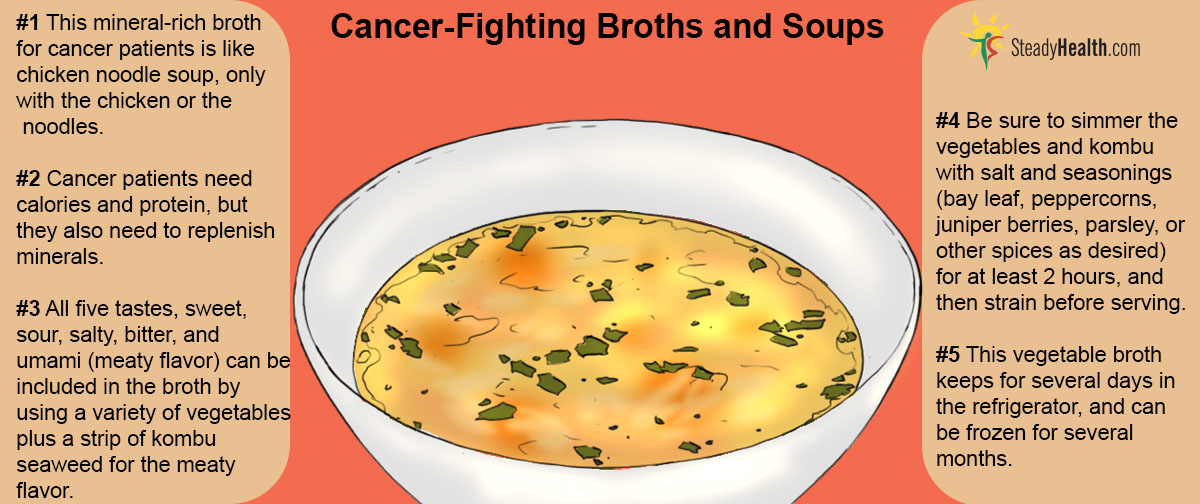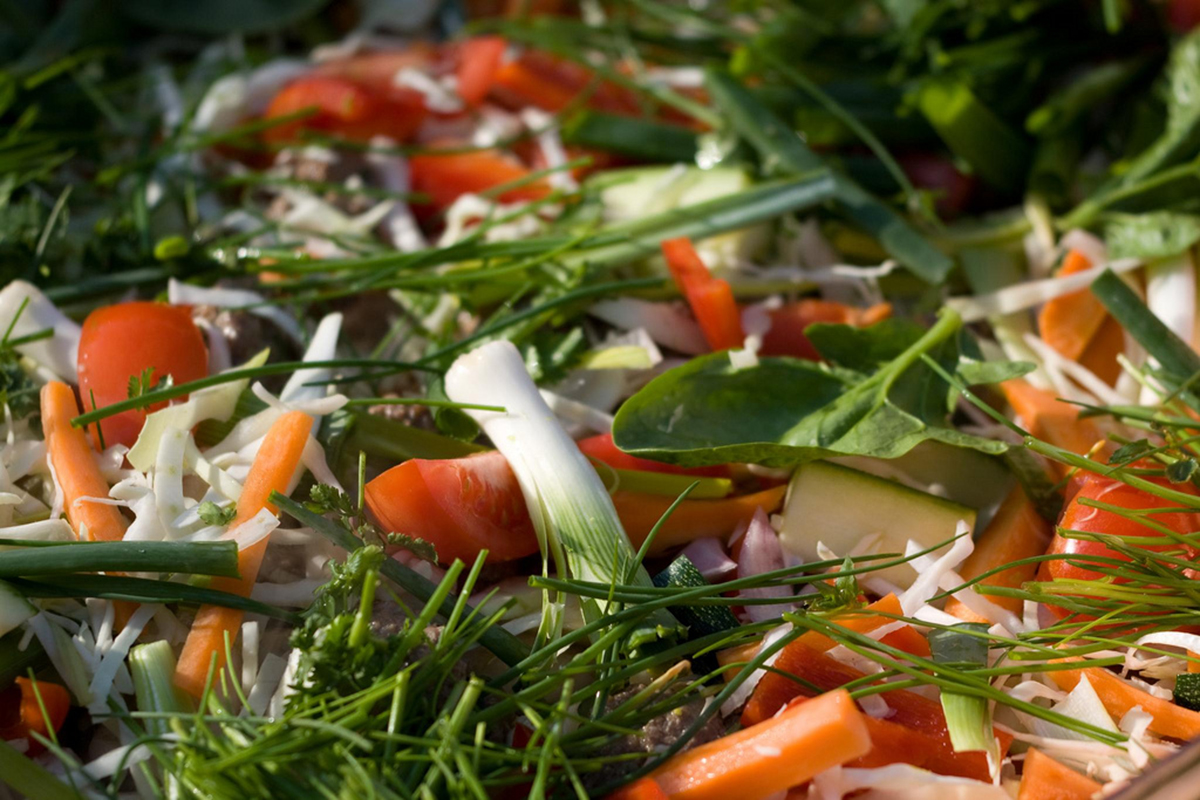Most of us who have had family members who had cancer have found cooking to be a major challenge. Most kinds of chemotherapy cause nausea and vomiting. Gastrointestinal distress usually is not a complication of radiation therapy, but radiation to the head and even to the chest can result in mucositis, painful sores in the lining of the mouth and on the tongue that make eating painful.

Making the situation even more complicated is the fact that cancer treatment alters taste perception.
And well meaning attempts to entice a cancer patient to eat by cooking his or her favorite foods when there is gastrointestinal upset can create a body memory that cancels out all the positive associations with the food. (As a general rule, it is never a good idea to cook someone's favorite foods on days they have stomach upset.)
At the same time cancer treatment discourages eating, cancer itself can alter the metabolism so that the body starts wasting glucose and making up the difference by converting the amino acids in the proteins in the muscles and white blood cells into sugar. Wasting disease can cause even more damage than metastatic tumors do, to the profound distress of the patient and the horrified frustration of family members and friends trying to take care of them.
See Also: Anti-Cancer Diet: Cancer Fighting Foods and Spices
What can people who provide care to cancer patients do to adjust cooking to their condition?
- Don't worry about feeding lots of "miracle foods." Even if there were a particular food that cured cancer, and there isn't, eating when you feel worn out from the disease or dyspeptic from treatment would create an aversion to it. And as a corollary:
- Try to provide a variety of foods. Variety of textures, tastes, shapes, sizes, smells, and colors increases appetite. Be careful with bitter flavors. Even if the person you are cooking for likes them, the sensation of bitterness on the tongue causes the release of acid in the stomach.
- Make food tasty by adding a little sweetness (such as a touch of sugar or maple syrup), a little saltiness (in liquids, salt crystals can irritate the lining of the mouth), a little umami flavor (from a protein food, tomatoes if they can be tolerated, or kombu), and a little acid (from a squeeze of lemon juice). Sometimes when cancer patients can taste one kind of flavor, they can still taste the others. Including all flavors in every bite makes eating more pleasant.
- Minimize mouth pain by avoiding hard or crusty foods. Moistness makes food more tolerable. Bread pudding is more likely to be tolerated than crusty bread, cracker crumbs are more likely to be tolerated than whole crackers, and soups and stews, appropriately seasoned, are easier to eat than roasts and roasted vegetables or fried foods.
- When digestive upset is a problem, stick to bland foods, preferably foods that aren't eaten very often. The brain associates nausea, vomiting, and diarrhea with the food eaten immediately before the symptom.
I'd like to take credit for this recipe myself, but Rebecca Katz's preparation tastes so much better than my own I'm sharing it here.
Making The Magic Mineral Broth
Rebecca Katz's Magic Mineral Broth provides nutrients most recipes for cancer cooking leave out. Most people focus on carbohydrates and protein and leave out minerals. Electrolyte minerals are critical in cancer recovery because they help cells normalize their responses to and uses of glucose.

Katz's broth recipe isn't so "magical" that it actually kills cancer, but it does provide all the minerals the body needs to function normally, in a form that is easy to prepare, easy to consume, and just tasty enough to be pleasant without creating food associations should side effects of treatment erupt just after it is eaten.
Here's how to make the broth:
- Use thoroughly washed but unpeeled vegetables of all kinds. Much of the mineral content of vegetables is in the peel--but you don't need the mineral content of the soil they grew in.
- Use a variety of vegetables, the more the better. As mentioned earlier in this article, variety increases appetite. Make sure to include some sweet vegetables, such as diced carrots or sweet potatoes. Make sure to include a salty vegetable, such as celery sticks. Include something green, such as parsley or spinach. Don't leave out pungent vegetables, such as leeks, garlic, and onion, all three are fine in the same broth. Use a long (8 inch/20 cm) strip of dried kombu seaweed to provide a meaty flavor without the meat. And season with peppercorns, juniper berries, allspice, and sea salt, sea salt providing more flavor than regular table salt. Just about any vegetable is OK in the mix, but make sure you have all the taste elements included.
- Place all the vegetables and seasonings in a large stockpot, typically 12 quarts (12 liters). Cover with water and bring to a boil. Then lower the heat so that the veggies and spices simmer for at least two hours.
- Press the thoroughly boiled vegetables through a sieve with a heat-proof container beneath to collect the broth. The broth should be a clear liquid without bits and pieces of vegetables (which could cause mouth irritation) floating in it. Allow to cool to room temperature before refrigerating or freezing. Refrigerated broth keeps up to 5 days in an enclosed container. Frozen broth keeps up to two months.
See Also: Cooking For Cancer Treatment: Making Food Taste Good When Everything Tastes Awful
Slowly cooked veggies and herbs release chemicals that form new compounds in hot water, and some of these compounds stimulate the immune system, particularly the neutrophils that "zap" infections.
Rebecca Katz's broth is refreshing and nutritious. It is not a substitute for the carbohydrates, protein, and fat that a cancer fighting diet has to provide, but it is a great pick me up for rough days when eating isn't easy. Everyone who cooks for cancer patients should have a copy of her book, The Cancer Fighting Kitchen, published by Ten Speed Press (2010).
- Rister, R. Healing Without Medication (Basic Health Books, 2003)
- Photo courtesy of Mike Haller by Flickr: www.flickr.com/photos/mhaller1979/3456875252


Your thoughts on this